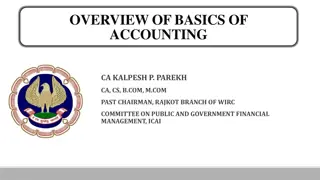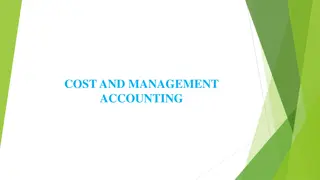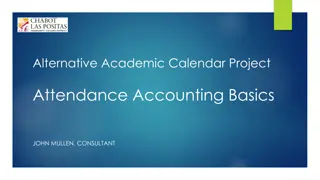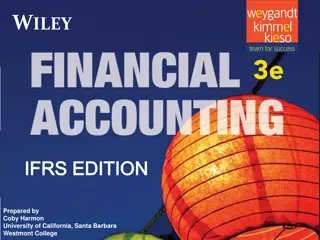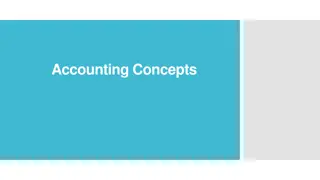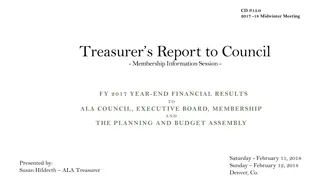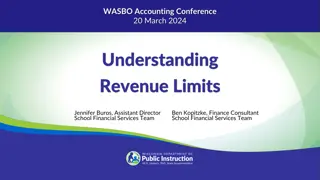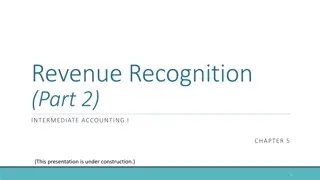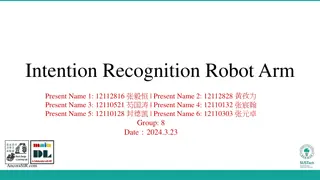Revenue Recognition Principles for Financial Accounting Overview
Overview of revenue recognition principles for introductory financial accounting, highlighting the five-step process: contract identification, performance obligations, transaction price determination, allocation, and revenue recognition. Example provided with L.L. Bean and Michelle Sylvester's transaction.
Download Presentation

Please find below an Image/Link to download the presentation.
The content on the website is provided AS IS for your information and personal use only. It may not be sold, licensed, or shared on other websites without obtaining consent from the author.If you encounter any issues during the download, it is possible that the publisher has removed the file from their server.
You are allowed to download the files provided on this website for personal or commercial use, subject to the condition that they are used lawfully. All files are the property of their respective owners.
The content on the website is provided AS IS for your information and personal use only. It may not be sold, licensed, or shared on other websites without obtaining consent from the author.
E N D
Presentation Transcript
Revenue Recognition Revenue Recognition Principles for Introductory Principles for Introductory Financial Accounting Financial Accounting WENDY TIETZ WENDY TIETZ, PHD, CPA, CMA, KENT STATE
Summary of revenue recognition changes Item 1: Five step process Item 2: New accounts are included in sales returns accrual Item 3: Sales are recorded net Item 4: Performance obligations are recorded separately See page 2
Item 1 Overview: Five step process Step 1: Identify the contract(s) with a customer. Step 2: Identify the performance obligations in the contract. Step 3: Determine the transaction price. Step 4: Allocate the transaction price to the performance obligations. Step 5: Recognize revenue when, or as, it satisfies each performance obligation.
Item 1 Example A: Record individual sale and cost of goods sold On November 1, 2015, L.L. Bean received an order from Michelle Sylvester for one pair of L.L. Bean 8 boots (aka duck boots. ) The selling price of the boots is $109. These boots are on backorder; L.L. Bean actually ships the boots to Sylvester on January 2, 2016. Sylvester s credit card is charged when the boots ship; L.L. Bean treats the credit card sale as cash since it can deposit the credit card receipts into its bank account immediately. Assume that L.L. Bean s cost of these boots is $44.
Step 1: Identify the contract(s) with a customer. Analysis: Contract is between L.L. Bean and Michelle Sylvester.
Step 2: Identify the performance obligations in the contract. Analysis: L.L. Bean is obligated to deliver boots and Michelle Sylvester is obligated to pay for the boots.
Step 3: Determine the transaction price. Analysis: The selling price is $109.
Step 4: Allocate the transaction price to the performance obligations. Analysis: There is one performance obligation to ship the boots.
Step 5: Recognize revenue when, or as, it satisfies each performance obligation. Analysis: When L.L. Bean ships the boots on January 2, 2016, its performance obligation is satisfied.
Journal entry 1: Journalize the sale of these boots. Include the date on the journal entry. 2016 Date Accounts Debit Credit Jan 2 Cash 109 00 Sales revenue 109 00 To record the sale of boots
Journal entry 2: Journalize the cost of the boots sold. 2016 Date Accounts Debit Credit Jan 2 Cost of goods sold 44 00 Inventory 44 00 To record the cost of boots sold
Item 1 Example B: Record monthly sales and cost of goods sold During the month of January 2016, assume that L.L. Bean s total boot sales are $140,000. All sales are cash sales. The cost of the boots sold was $56,000.
Journal entry 1: Record the January sales of the boots on January 31. 2016 Date Accounts Debit Credit Jan 31 Cash 140,000 00 Sales revenue 140,000 00 To record the sale of boots sold in January
Journal entry 2: Record the January cost of the boots sold on January 31. 2016 Date Accounts Debit Credit Jan 31 Cost of goods sold 56,000 00 Inventory 56,000 00 To record the cost of boots sold in January
Item 2 Example C: Adjusting entry for sales returns estimate L.L. Bean offers a 100% satisfaction guarantee. Assume that L.L. Bean experiences a 10% return rate.
Journal entry 1: Make the adjusting entry for January to reflect the estimated refunds for the January boots sales of $140,000. 2016 Date Accounts Debit Credit Jan 31 Sales revenue 14,000 00 Refund liability 14,000 00 To accrue estimated returns of boots sold in January Calculation: $140,000 x 10%
Journal entry 2: Make the adjusting entry to record the cost of estimated returns for January. Use a COGS of 40% of sales. 2016 Date Accounts Debit Credit Jan 31 Estimated returns inventory 5,600 00 Cost of goods sold 5,600 00 To accrue estimated inventory returns Calculation: $140,000 x 10% x 40%
Item 2 Example D: Return of merchandise Now assume that Michelle Sylvester returns the L.L. Bean boots on January 10, 2016 (she had received the boots in early January) for a full refund of $109.
Journal entry 1: Record the return of the boots by Sylvester. 2016 Date Accounts Debit Credit Jan 10 Refund liability 109 00 Cash 109 00 To record the return of M. Sylvester boots
Journal entry 2: Record the cost of the boots returned by Sylvester. 2016 Date Accounts Debit Credit Jan 10 Inventory 44 00 Estimated returns inventory 44 00 To record the cost of the Sylvester boots returned
Item 3 Example E: Sell merchandise with sales discount and expect customer to take the discount; payment in discount period Now assume that Stonecreek Outfitters is an authorized reseller of L.L. Bean boots.
Journal entry 1: On January 4, 2016, L.L. Bean receives an order from Stonecreek for $2,500 and ships same day. Terms are 2/10, net 30. 2016 Date Accounts Debit Credit Jan 4 Accounts receivable 2,450 00 Sales revenue 2,450 00 To record $2,500 sale to Stonecreek Outfitters, 2/10, n30 Calculation: $2,500 x (100% - 2%)
Journal entry 2: On January 12, 2016, Stonecreek pays its invoice to L.L. Bean. 2016 Date Accounts Debit Credit Jan 4 Cash 2,450 00 Accounts receivable 2,450 00 To record collection from Stonecreek Outfitters
Item 3 Example F: Sell merchandise with sales discount and expect the customer to take the discount; payment NOT in discount period Now assume that Wild Mountain Sports is an authorized reseller of L.L. Bean boots.
Journal entry 1: On February 6, 2016, L.L. Bean receives an order from Wild Mountain for $4,000 and ships same day. Terms are 2/10, net 30. 2016 Date Accounts Debit Credit Feb 6 Accounts receivable 3,920 00 Sales revenue 3,920 00 To record $4,000 sale to Wild Mountain Sports, 2/10, n30 Calculation: $4,000 x (100% - 2%)
Journal entry 2: On February 20, 2016, Wild Mountain pays its invoice to L.L. Bean. 2016 Date Accounts Debit Credit Feb 20 Cash 4,000 00 Accounts receivable 3,920 00 Sales discounts forfeited 80 00 To record collection from Wild Mountain Sports
Item 4 Example G: Sell items that include two performance obligations On March 10, 2016, L.L. Bean sells one pair of L.L. Bean 8 boots (aka duck boots ) to Dana Smith in its Lyndhurst, Ohio, store. The selling price of the boots is $109; Smith pays cash at the time of sale. During the month of March, L.L. Bean is running a promotion that awards $20 in L.L. Bean Dollars for every $100 spent in its stores. Accordingly, Smith receives $20 in L.L. Bean Dollars at the time of purchase. These L.L. Bean Dollars can be used the same as cash at any future date at any L.L. Bean store or its Website.
Step 1: Identify the contract(s) with a customer. Analysis: Contract is between L.L. Bean and Dana Smith.
Step 2: Identify the performance obligations in the contract. Analysis: L.L. Bean is obligated to hand over the boots now and $20 of merchandise in the future. Dana Smith is obligated to pay for the boots at the point of purchase.
Step 3: Determine the transaction price. Analysis: The selling price is $109.
Step 4: Allocate the transaction price to the performance obligations. Analysis: The purchase price of $109 needs to be allocated between the boots and the $20 L.L. Bean Dollars. $89 will be allocated to the purchase price of the boots and $20 will be allocated to the L.L. Bean Dollars (unearned revenue.)
Step 5: Recognize revenue when, or as, it satisfies each performance obligation. Analysis: Analysis: $89 is recognized at the point of sale. The $20 L.L. Bean Dollars (unearned revenue) will be recognized when Smith uses the $20 L.L. Bean Dollars to purchase something in the future.
Journal entry: Journalize the sale of these boots. (Do not make the COGS entry.) 2016 Date Accounts Debit Credit Mar 10 Cash 109 00 Sales revenue 89 00 Unearned revenue - L.L. Bean Dollars 20 00 To record sale of boots with L.L. Bean Dollars promotion
Item 4 Example H: Recognize use of L.L. Bean Dollars Now let s say that Smith uses the $20 in L.L. Bean Dollars on June 5, 2016, when she purchases a shirt at the L.L. Bean Store in Lyndhurst for a selling price of $43. She pays cash of $23 at the point of purchase.
Journal entry: Journalize the sale of the shirt and the use of the L.L. Bean Dollars by Smith. (Do not make the COGS entry.) 2016 Date Accounts Debit Credit Jun 5 Cash 23 00 Unearned revenue - L.L. Bean Dollars 20 00 00 Sales revenue 43 00 To record sale of shirt to Dana Smith
Class materials Go to Accounting in the Headlines blog https://accountingintheheadlines.com/ Includes student handouts and solutions from today wtietz@kent.edu | @WendyTietz
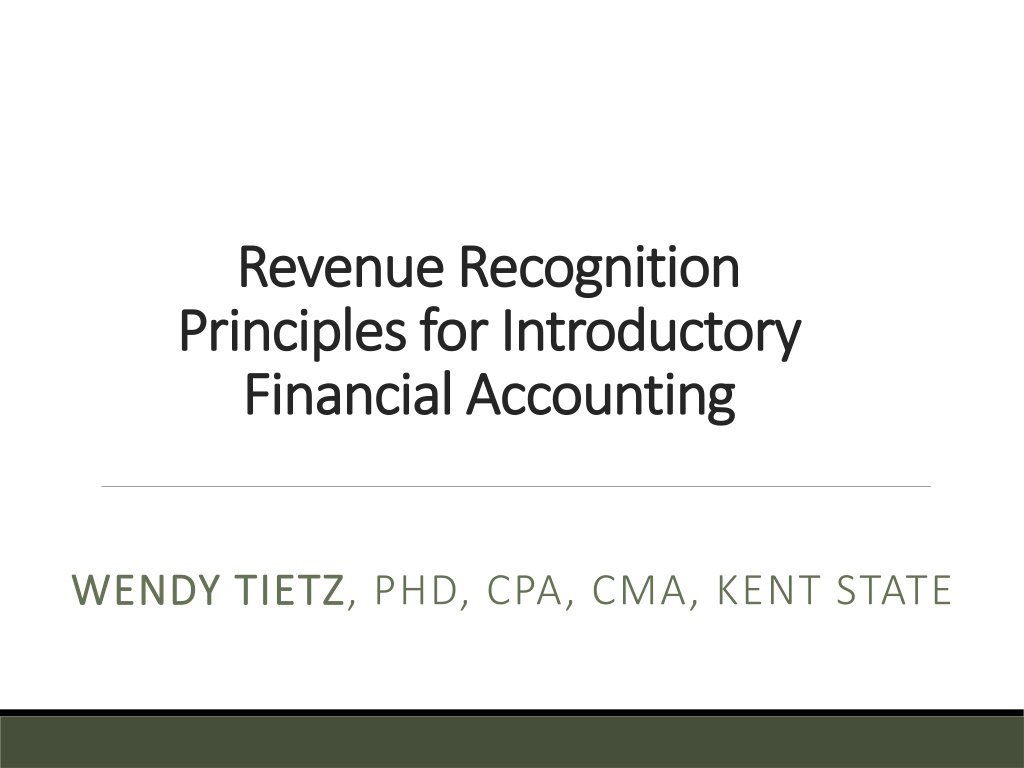
 undefined
undefined





